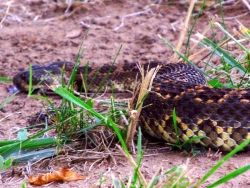
Photo, left: rattlesnake in Ramona, by Elena Pena
By Miriam Raftery
September 3, 2014 (San Diego’s East County) – Neurotoxic snake bites, known as “super bites”, were formerly rare in our region, found mainly in the Mojave Desert. But 10 News reports these serious bites are occurring now in suburban areas of San Diego and East County.
A dog with a neurotoxin bite in Del Cerro, for example, went into shock and had difficulty walking. The dog was treated at Pet Emergency and Specialty Center in La Mesa, where vets told 10 news that three of the ten snakebites treated in the past week have been neurotoxic bites.
Some doctors have theorized that Mojave green rattlesnakes, the most potent species of rattlesnake, may have made their way into our region or cross bred with other rattlers to produce more toxic venom. A fisherman bitten along Boulder Creek near Julian in 2010 lost conscienciousness and died within minutes, as ECM reported, one of several severe reactions seen recently in humans as well as pets.
If your or your pet is bitten by a rattlesnake, it’s important to seek out medical treatment immediately, since anti-venom injections can save lives.








Comments
Expert opinion?
Past stories on Mojave Greens found here
LK -- Our story was actually based also on earlier reports in recent years indicating Mojave Greens are being found here. Here are a few of the stories:
Mission Valley News reported a sighting of a Mojave Green rattlesnake in Mission Trails Regional Park recently, and ran a photo: http://scoopsandiego.com/mission_valley_news/local_news/summer-yields-th...
Animal Urgent Care's site lists Mojave Greens as among the species now found across the county: http://www.animalurgentcare.com/Mobile/article.cfm?ArticleNumber=2 A little boy was reportedly bitten by a Mojave Green near Camp Pendleton, the
NY Daily News and others reported: http://www.nydailynews.com/life-style/health/california-boy-bitten-rattl...
Anecdotes vs science - let's not start killing more snakes
Rattlers
The Best Care Anywhere